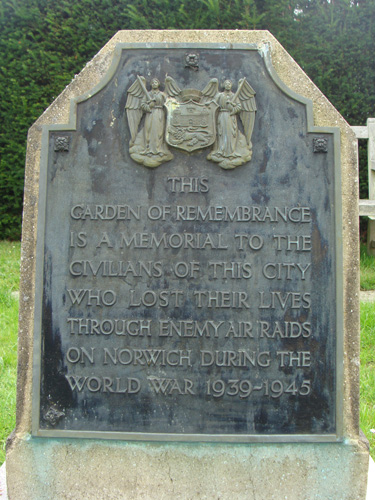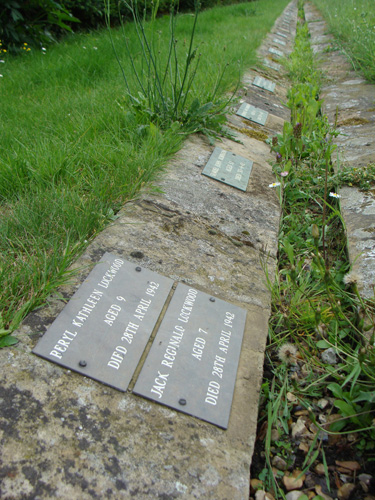How does that hoary old saying go, “lies, damned lies and statistics!” Well, Mark Twain’s famous old line came to mind the other day, though not quite in the manner originally intended, namely to prop up a weak argument. In my case, it was simply a measure of my frustration at trying to unravel the absolute truth over the tally of deaths and injuries that were connected with the Norwich Blitz.

The original graves in Norwich's Earlham cemetery
Now, I’ll readily admit that maths was never my strong point at school. In fact, I managed to confound my teachers at the CNS by failing my O Level retake with a worse mark than in my original exam, despite having extra tuition! But even allowing for having a poor head for figures, I can’t help feeling that many more researchers will have shared my frustration at trying to track down the most definitive list of casualties, whether it be connected with actions fought on distant battlefields or air raids close to home. In this respect, I suspect Norwich is no different from many other blitzed cities.
Part of me feels that it shouldn’t matter too much, that we shouldn’t get hung up on whether 160 or 170 people died on the night of April 27/28, 1942 and that it’s the bigger picture that counts. But another part of me feels it matters a lot; it matters because it is an important aspect of trying to create an accurate picture of what occurred and because every death deserves to be remembered as an individual human tragedy.
What set me thinking about all of this was an email from Sue Bamford, mum of our future son-in-law Tom. She has been delving into her family history in recent years. Like many of others, she has unravelled painful and poignant connections with our country’s warring past; great uncles killed in the Great War. More recently, though she has discovered a tragic link with the second world war on the home front. Sarah Ann Sheldon, her late father’s maternal grandmother, is listed among the Norwich civilians who died as a result of the second Baedeker Blitz, the same raid that devastated a large portion of the city centre, including Curl’s (now Debenhams), Woolworth’s and Caley’s. What made her death unusual, however, was that she died not during the bombing, nor even of injuries sustained in the attack, but of a heart attack suffered shortly afterwards. She was 72.
Sue writes: “She died… after leaving their air raid shelter at 196 Nelson Street and seeing the devastation in the street. So I suppose she died because of the bombing but not directly from the bombing.”
It makes me wonder if there were any other cases like Sarah Sheldon. The shock and the stress must have been immense, especially among frail and elderly people. Their lives had been turned upside down and everything they had worked for had, in all too many cases, been destroyed.
Sue’s email had got me thinking and then two more things happened to focus my mind on those infernal casualty lists. Firstly, I received a letter from Blitz researcher Norman Bacon, and then, during a meeting with Ghost Blitz photographer Nick Stone, I came across a record of air raid deaths in the city that I had never seen before. But back to Norman. He was querying the figures I cited in my book and wondered what my source had been. He also provided his own record of deaths. Interestingly, it differed not only from my own, but from those that have been quoted by previous Blitz historians, Joan Banger, Bob Collis and Frank Meeres. They all agree on 162 killed during the first April raid and 69 killed on the second raid two nights later. Initially, I confess, I was tempted to go with those figures myself, but in the end I decided to stick with my principles of relying on primary sources and used the figures that were contained in the Consolidated Report on the Effects of Heavy Air Attack on the City of Norwich, April and May 1942 which is held in the National Archives. This paper had been prepared in the immediate aftermath of the attacks and, therefore, had the advantage of being an original contemporary record. It gave the number of deaths as 158 in the first raid and 67 in the second. Norman, on the other hand, has 174 (broken down into 68 men, 78 women, 24 children and 4 servicemen) for the first and 59 (24 men, 31 women and 4 children) in the second. As yet, I am still waiting to discover the source for these figures and am looking forward to comparing them with the total contained in the private record that Nick has promised to pass on.

Earlham Cemetery Today
Of course, it is entirely possible that it will supply us with an entirely new set of statistics, thus muddying the water still further. Rather than helping us to find that elusive definitive casualty list it may simply add more unanswered questions. All of which makes me wonder whether we will ever know with certainty just how many people died and were injured during the terrible raids of 70 years ago. Ultimately, we may have to fall back on that unsatisfactory but honest solution by offering a range of figures provided by the various sources.

Earlham Cemetery Today
As I said at the start, “lies, damned lies and statistics!”
